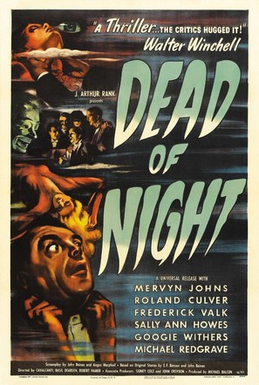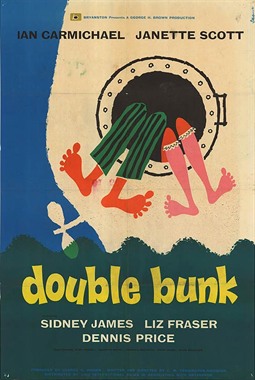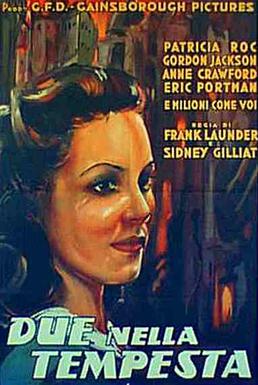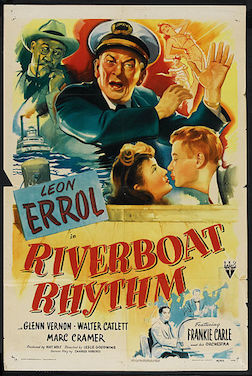
Joan Mary Waller Greenwood was an English actress. Her husky voice, coupled with her slow, precise elocution, was her trademark. She played Sibella in the 1949 film Kind Hearts and Coronets, and also appeared in The Man in the White Suit (1951), Young Wives' Tale (1951), The Importance of Being Earnest (1952), Stage Struck (1958), Tom Jones (1963) and Little Dorrit (1987).

Naunton Wayne, was a Welsh character actor, born in Pontypridd, Glamorgan, Wales. He was educated at Clifton College. His name was changed by deed poll in 1933.

Dead of Night is a 1945 black and white British anthology supernatural horror film, made by Ealing Studios. The individual segments were directed by Alberto Cavalcanti, Charles Crichton, Basil Dearden and Robert Hamer. It stars Mervyn Johns, Googie Withers, Sally Ann Howes and Michael Redgrave. The film is best remembered for the concluding story featuring Redgrave and an insane ventriloquist's malevolent dummy.

Michael James Radford is an English film director and screenwriter. He began his career as a documentary director and television comedy writer before transitioning into features in the early 1980s.

Arthur Basil Radford was an English character actor who featured in many British films of the 1930s and 1940s.

Double Bunk is a 1961 British black-and-white comedy film directred by C.M. Pennington-Richards and starring Ian Carmichael and Sid James.

The Lady Vanishes is a 1938 British mystery thriller film directed by Alfred Hitchcock, starring Margaret Lockwood and Michael Redgrave. Written by Sidney Gilliat and Frank Launder, based on the 1936 novel The Wheel Spins by Ethel Lina White, the film is about an English tourist travelling by train in continental Europe who discovers that her elderly travelling companion seems to have disappeared from the train. After her fellow passengers deny ever having seen the elderly lady, the young woman is helped by a young musicologist, the two proceeding to search the train for clues to the old lady's disappearance.

Millions Like Us is a 1943 British propaganda film, showing life in a wartime aircraft factory in documentary detail. It stars Patricia Roc, Gordon Jackson, Anne Crawford, Basil Radford, Naunton Wayne, Moore Marriott and Eric Portman.

Charters and Caldicott started out as two supporting characters in the 1938 Alfred Hitchcock film The Lady Vanishes. The pair of cricket-obsessed characters were played by Naunton Wayne and Basil Radford. The characters were created by Frank Launder and Sidney Gilliat. The duo became very popular and were used as recurring characters in subsequent films and in BBC Radio productions. Charters and Caldicott have also been played by other actors, and they eventually had their own BBC television series.

Crook's Tour is a 1940 British comedy spy film directed by John Baxter featuring Charters and Caldicott. It is adapted from a BBC radio serial of the same name.
The Huggetts are a fictional family who appear in a series of British films which were released in the late 1940s by Gainsborough Pictures. The films centre on the character of Joe Huggett, played by Jack Warner, the head of a working class London family. Along with the Gainsborough melodramas, the Huggett films proved popular and lucrative for the studio. All four films were directed by Ken Annakin and produced by Betty E. Box.
It's Not Cricket may refer to:

It's Not Cricket is a 1949 British comedy film directed by Alfred Roome and starring Basil Radford, Naunton Wayne, Susan Shaw and Maurice Denham. It is the second of two starring films for Radford and Wayne who appeared as supporting players in ten other films. It was also one of the final films made by Gainsborough Pictures before the studio was merged into the Rank Organisation.

The Calendar is a black and white 1948 British drama film directed by Arthur Crabtree and starring Greta Gynt, John McCallum, Raymond Lovell and Leslie Dwyer. It is based on the 1929 play The Calendar and subsequent novel by Edgar Wallace. A previous version had been released in 1931.

Treasure Hunt is a 1952 British comedy film directed by John Paddy Carstairs and starring Martita Hunt, Jimmy Edwards, Naunton Wayne and Athene Seyler. It is based on the 1949 play Treasure Hunt by Molly Keane and John Perry.

Stop Press Girl is a 1949 British fantasy comedy film directed by Michael Barry and starring Sally Ann Howes, Gordon Jackson, Basil Radford and Naunton Wayne; the latter two appearing in several different roles in the film. It marked an early screen appearance by Kenneth More, who later co-starred with Howes in The Admirable Crichton.

Operation Bullshine is a 1959 British colour comedy film directed by Gilbert Gunn and starring Donald Sinden, Barbara Murray and Carole Lesley. The working title of the film was Girls in Arms that features as a marching song in the film. Gunn had filmed Girls at Sea the previous year. The new title, based on an American euphemism for a very British word with the same meaning (bullshite), comes from the frenzied activity preparing for their brigadier's surprise inspection. The film features 1956 Olympic gold medallist Judy Grinham as a physical training instructor.

Made in Heaven is a 1952 British Technicolor comedy film directed by John Paddy Carstairs which stars David Tomlinson, Petula Clark and Sonja Ziemann. The screenplay was based on a story by William Douglas-Home. It was shot at Pinewood Studios outside London. The film's sets were designed by the art director Maurice Carter.

Riverboat Rhythm is a 1946 American comedy film directed by Leslie Goodwins and written by Charles E. Roberts. The film stars Leon Errol, Glenn Vernon, Walter Catlett, Joan Newton, Marc Cramer, and Jonathan Hale. The film was released on February 13, 1946, by RKO Radio Pictures.
For Love of You is a 1933 British musical comedy film directed by Carmine Gallone and starring Arthur Riscoe, Naunton Wayne and Franco Foresta. It was made at British and Dominions Elstree Studios. It is the sequel to Going Gay.

















